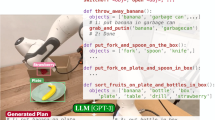Abstract
The problem of finding sequences of motions for the assembly of a given object consisting of polyhedral parts arises in assembly planning. We describe an algorithm to compute the set of all translations separating two polyhedra withn vertices inO(n4) steps and show that this is optimal. Given an assembly ofk polyhedra with a total ofn vertices, an extension of this algorithm identifies a valid translation and removable subassembly inO(k2n4) steps if one exists. Based on the second algorithm, a polynomial-time method for finding a complete assembly sequence consisting of single translations is derived. An implementation incorporates several changes to achieve better average-case performance; experimental results obtained for simple assemblies are described.
Similar content being viewed by others
References
A. V. Aho, J. E. Hopcroft, and J. D. Ullman,Data Structures and Algorithms, Addison-Wesley, Reading, MA, 1983.
E. M. Arkin, R. Connelly, and J. S. B. Mitchell. On monotone paths among obstacles, with applications to planning assemblies.Proc. ACM Symp. on Computational Geometry, 1989, pp. 334–343.
B. Chazelle, L. J. Guibas, and D. T. Lee. The power of geometric duality.BIT, 25: 76–90, 1985.
R. J. Dawson. On removing a ball without disturbing the others.Mathematics Magazine, 57(1): 27–30, 1984.
H. Edelsbrunner.Algorithms in Combinatorial Geometry. Springer-Verlag, Heidelberg, 1987.
L. S. Homem de Mello and A. C. Sanderson. Automatic generation of mechanical assembly sequences. Technical Report CMU-RI-TR-88-19, Robotics Institute, Carnegie-Mellon University, 1988.
S. S. Krishnan and A. C. Sanderson. Path planning algorithms for assembly sequence planning.Proc. Internat. Conf. on Intelligent Robotics, 1991, pp. 428–439.
J.-C. Latombe.Robot Motion Planning. Kluwer, Boston, 1991.
T. Lozano-Pérez. Spatial planning: A configuration space approach.IEEE Transactions on Computers, 32(2): 108–120, 1983.
J. S. B. Mitchell. Personal Communication, December 1990.
B. K. Natarajan. On planning assemblies.Proc. ACM Symp. on Computational Geometry, 1988, pp. 299–308.
R. Pollack, M. Sharir, and S. Sifrony. Separating two simple polygons by a sequence of translations.Discrete & Computational Geometŕy, 3: 123–136, 1988.
F. P. Preparata and M. I. Shamos.Computational Geometry: An Introduction. Springer-Verlag, New York, 1985.
J. Snoeyink and J. Stolfi. Objects that cannot be taken apart with two hands.Discrete & Computational Geometry, 12: 367–384, 1994.
G. T. Toussaint. Movable separability of sets. In G. T. Toussaint, editor,Computational Geometry. Elsevier, North-Holland, Amsterdam, 1985.
G. T. Toussaint. On separating two simple polygons by a single translation.Discrete & Computational Geometry, 1989 4: 265–278.
Author information
Authors and Affiliations
Additional information
Communicated by F. P. Preparata.
This research was funded by DARPA Contract N00014-88-K-0620 (Office of Naval Research) and the Stanford Integrated Manufacturing Association (SIMA).
Rights and permissions
About this article
Cite this article
Schweikard, A., Wilson, R.H. Assembly sequences for polyhedra. Algorithmica 13, 539–552 (1995). https://doi.org/10.1007/BF01189068
Received:
Revised:
Issue Date:
DOI: https://doi.org/10.1007/BF01189068




